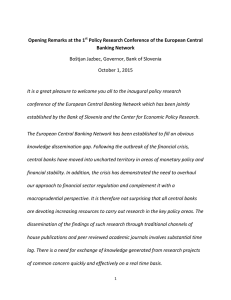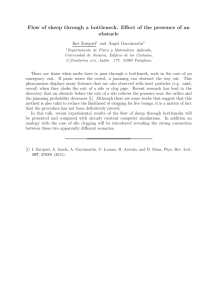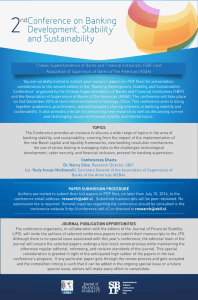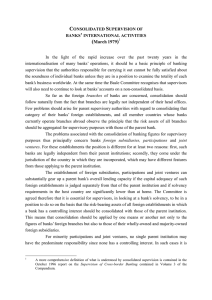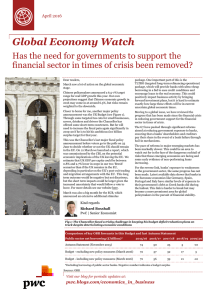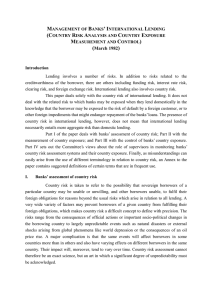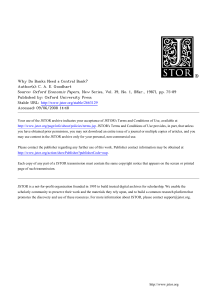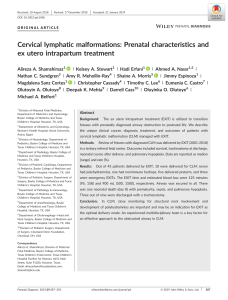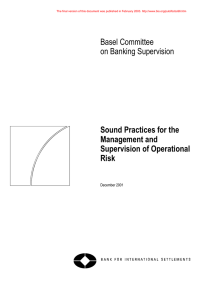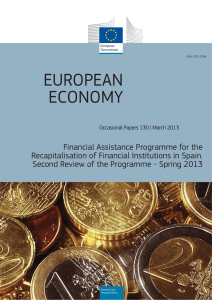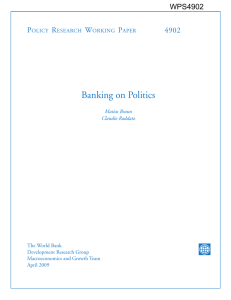Exit Strategies: Bank of Mexico
Anuncio
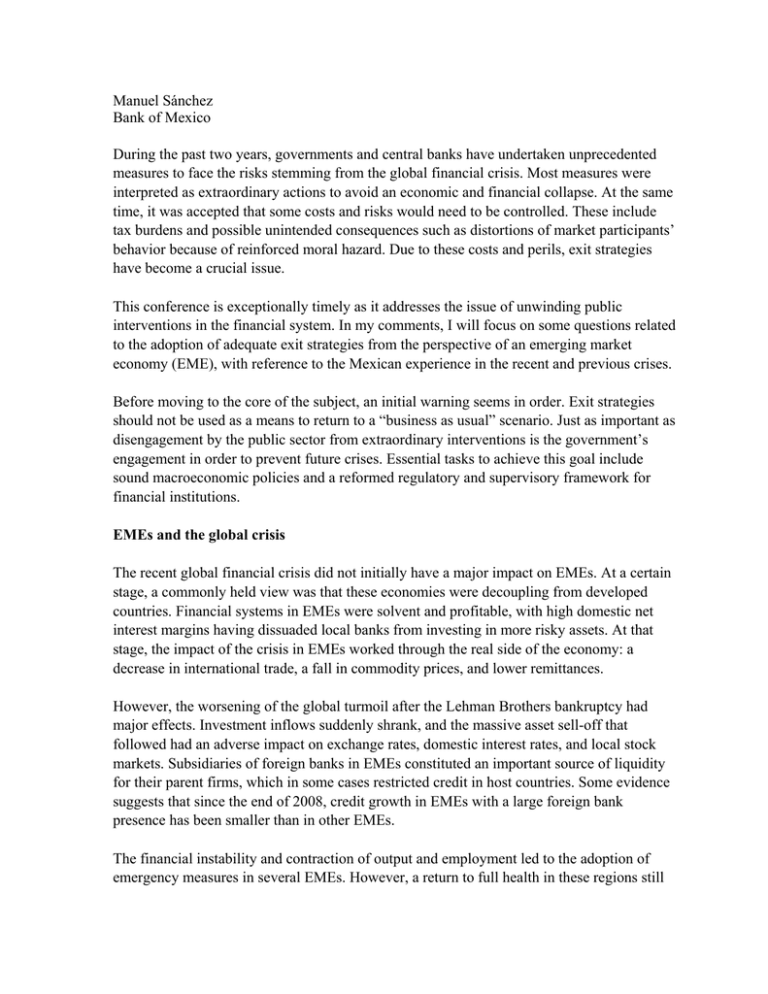
Manuel Sánchez Bank of Mexico During the past two years, governments and central banks have undertaken unprecedented measures to face the risks stemming from the global financial crisis. Most measures were interpreted as extraordinary actions to avoid an economic and financial collapse. At the same time, it was accepted that some costs and risks would need to be controlled. These include tax burdens and possible unintended consequences such as distortions of market participants’ behavior because of reinforced moral hazard. Due to these costs and perils, exit strategies have become a crucial issue. This conference is exceptionally timely as it addresses the issue of unwinding public interventions in the financial system. In my comments, I will focus on some questions related to the adoption of adequate exit strategies from the perspective of an emerging market economy (EME), with reference to the Mexican experience in the recent and previous crises. Before moving to the core of the subject, an initial warning seems in order. Exit strategies should not be used as a means to return to a “business as usual” scenario. Just as important as disengagement by the public sector from extraordinary interventions is the government’s engagement in order to prevent future crises. Essential tasks to achieve this goal include sound macroeconomic policies and a reformed regulatory and supervisory framework for financial institutions. EMEs and the global crisis The recent global financial crisis did not initially have a major impact on EMEs. At a certain stage, a commonly held view was that these economies were decoupling from developed countries. Financial systems in EMEs were solvent and profitable, with high domestic net interest margins having dissuaded local banks from investing in more risky assets. At that stage, the impact of the crisis in EMEs worked through the real side of the economy: a decrease in international trade, a fall in commodity prices, and lower remittances. However, the worsening of the global turmoil after the Lehman Brothers bankruptcy had major effects. Investment inflows suddenly shrank, and the massive asset sell-off that followed had an adverse impact on exchange rates, domestic interest rates, and local stock markets. Subsidiaries of foreign banks in EMEs constituted an important source of liquidity for their parent firms, which in some cases restricted credit in host countries. Some evidence suggests that since the end of 2008, credit growth in EMEs with a large foreign bank presence has been smaller than in other EMEs. The financial instability and contraction of output and employment led to the adoption of emergency measures in several EMEs. However, a return to full health in these regions still depends on the recovery of the developed world. The actions adopted in advanced countries to support their financial systems, together with their fiscal and monetary stimuli, have set the stage for the upturn. Proper exit strategies are crucial in order to maintain the improvement of economic prospects. Preconditions and the unwinding strategy Governments in many countries have taken numerous measures to support financial systems, including deposit insurance, guarantees of nondeposit liabilities, asset purchases or asset guarantees, special lending facilities and extraordinary central bank liquidity facilities, and capital injections and emergency loans. Exit from these interventions should aim at restoring sustainable financial stability and economic growth. To achieve a durable and safe disengagement by the public sector, certain preconditions seem desirable. In particular, it is necessary to verify that intermediaries no longer need support, as reflected in their decreased demand for assistance, available access to market sources of funding, and reconstructed balance sheets. This implies the strengthening of capital, reserve, and provisioning ratios under “fair value” conditions. Also, macroeconomic stability should be guaranteed in terms of sound monetary and fiscal policies, so that no undue future financial instability is built into current stimulus measures. On the other hand, economic recovery should clearly be underway, allowing banks to return to normal lending. Given these preconditions, several elements may contribute to a successful exit strategy. The first one is to price the measures in such a way that a market-based exit is a natural outcome. The incentives of market participants should lead them to draw less on support measures as markets normalize, for example in the cases of debt guarantees, central bank lending facilities, or haircuts to the assets exchanged in a balance-sheet cleanup plan. A second element is that the timing and sequencing of exit plans should depend on the progress of the preconditions mentioned above, which implies that the timing of withdrawal is partly endogenous and cannot be completely fixed in advance. Although some measures might have been established for a specific time period, others need to be flexible to accommodate unforeseen developments. A third element is to reconcile the steps of the exit plan with the implementation of any new regulatory and supervisory measures. The combination of higher requirements and lower support should not destabilize banks. A fourth element is to explore possible cross-border effects so that adequate internationally coordinated measures can be taken. For example, developing countries have been shown to be highly sensitive to relatively smaller changes in the global economic environment. Exit strategies from firm-specific actions may affect countries where those firms play a significant role. A fifth element is an adequate communication of plans to the public to avoid unnecessary surprises and gain social support. The advance notice of exit strategies, their objectives and timelines, will facilitate adjustment in the regions that expect some indirect impacts or spillover effects. Transparency and time consistency greatly increase a plan’s credibility. These elements uncover interdependencies among measures that may make the unwinding process particularly complex. For example, highly accommodative monetary policy in place for too long may provide incentives for carry-trade transactions that would cause asset price bubbles in EMEs; removal of public-sector support without enhanced regulatory rules may facilitate excessive risk-taking; and lack of international coordination may lead banks and their creditors to arbitrage facilities in different countries. Mexico’s experience in times of crisis Let me now turn to Mexico’s experience with public-sector interventions during the past two crises, which may be useful to policymakers in other countries. The 1995 crisis brought about a sharp depreciation of the peso, a drastic rise in inflation and interest rates, and a deep recession. As a result, the capacity of borrowers to honor their debts was severely impaired, which caused a deterioration of banks’ balance sheets. The authorities responded with a series of measures to stabilize the financial system. In the wake of the crisis, a dollar-credit window was established at the central bank to help banks service their obligations and reduce the volatility in a highly illiquid foreign exchange market. This facility charged a high dollar interest rate to ensure that the resources were used only for temporary liquidity shortages. The outstanding amount of dollar loans from the central bank peaked in April 1995, and by September of that year all banks had repaid them in full. Thus, the high rates charged on the facility gave financial institutions an incentive to exit, allowing for the facility’s quick termination. At the same time, to avoid panic, the government announced a blanket guarantee on banks’ liabilities. With the establishment of the new deposit insurance agency (IPAB) in 1999, the coverage was gradually reduced, and by 2005 it had reached its current coverage level (in U.S. dollars) of about $130,000 per depositor and institution. Also, a program was implemented for banks to sell their nonperforming loans (NPLs) in exchange for the injection of new capital. The deposit insurance agency bought two pesos of NPLs for each peso of new capital injected by shareholders. The NPLs acquired by the agency would still be managed by the selling bank. The scheme included a loss-sharing agreement under which, after 10 years, 30 percent of the losses would be assumed by the banks and 70 percent by the deposit insurance agency. Unfortunately, measures to fully capitalize the banking system and build conditions for a return to lending activities took several years. One reason was that NPLs were acquired with promissory notes that were nontradable, and, hence, banks could not sell them to finance lending. More importantly, capitalization was limited by legal restrictions on foreign ownership of banks, which were not completely abolished until 1999. Finally, it took three more years to approve reforms to improve the protection of creditors’ rights. In contrast, during the recent crisis, the emergency measures were milder and, in general, regarded as temporary, with the imposition of explicit deadlines and limits on the amounts of resources committed. An important difference from the previous crisis was the relative strength of the current banking system. Specifically, in the foreign exchange market, the Bank of Mexico conducted extraordinary interventions as well as daily auctions of dollars with and without a minimum price. The amount offered in the daily auctions was gradually reduced to zero in the case of those with no minimum price. Additionally, the Bank of Mexico and the Federal Reserve agreed on a currency swap line for up to $30 billion, with a deadline extended to February 2010. Finally, the IMF granted a one year contingent credit line to Mexico for about $47 billion. Both facilities are good examples of internationally coordinated measures. On another front, the sharp steepening of the yield curve had negative effects on institutional investors’ portfolios. To address those effects, the Bank of Mexico conducted interest rate swap auctions. Also, the government and the IPAB reduced the placement of medium- and long-term securities and increased the placement of short-term issues. At the same time, the central bank introduced an auction mechanism to acquire IPAB bonds and implemented the buyback of long-term debt. These measures have begun to see a gradual unwinding. In addition, regulations were amended so that, for a period of six months, investment funds were allowed to carry out purchases and sales of government debt securities with any financial firm belonging to their financial group. Finally, government-owned development banks launched temporary guarantee programs to facilitate the refinancing of commercial paper issued by businesses and by nonbank, nonmortgage-related financial firms for up to 50 percent, a program that closed to new users in July 2009. These guarantees were adequately collateralized, and their pricing reflected the firms’ debt ratings. Another guarantee program was implemented for nonbank mortgage financial institutions for up to 65 percent, which will conclude in 2010. In short, in comparison with the previous crisis episode, emergency measures in the recent crisis were considerably less extensive mainly because Mexico had a more resilient financial system, which, in turn, reflected a stronger and more efficient regulatory and supervisory framework as well as improvements in banks’ risk management and macroeconomic fundamentals. Concluding remarks In conclusion, careful consideration of the timing of exit from the various public sector interventions is needed. The magnitude of the global crisis, the interdependency of implemented measures, and the needed reforms of the financial system will likely make the exit a long process. Given that support measures may have undesirable moral hazard effects, it is imperative to implement new rules of the game that induce responsible risk taking in the future. This effort should devote special attention to minimizing the size of the “too big to fail” problem, a subject that deserves a whole conference in and of itself. Clear leadership and social consensus around exit strategies and pending reforms will be essential.
